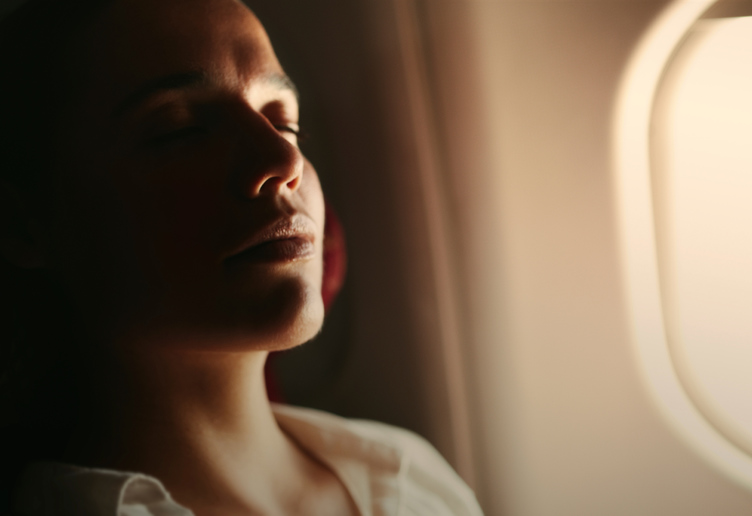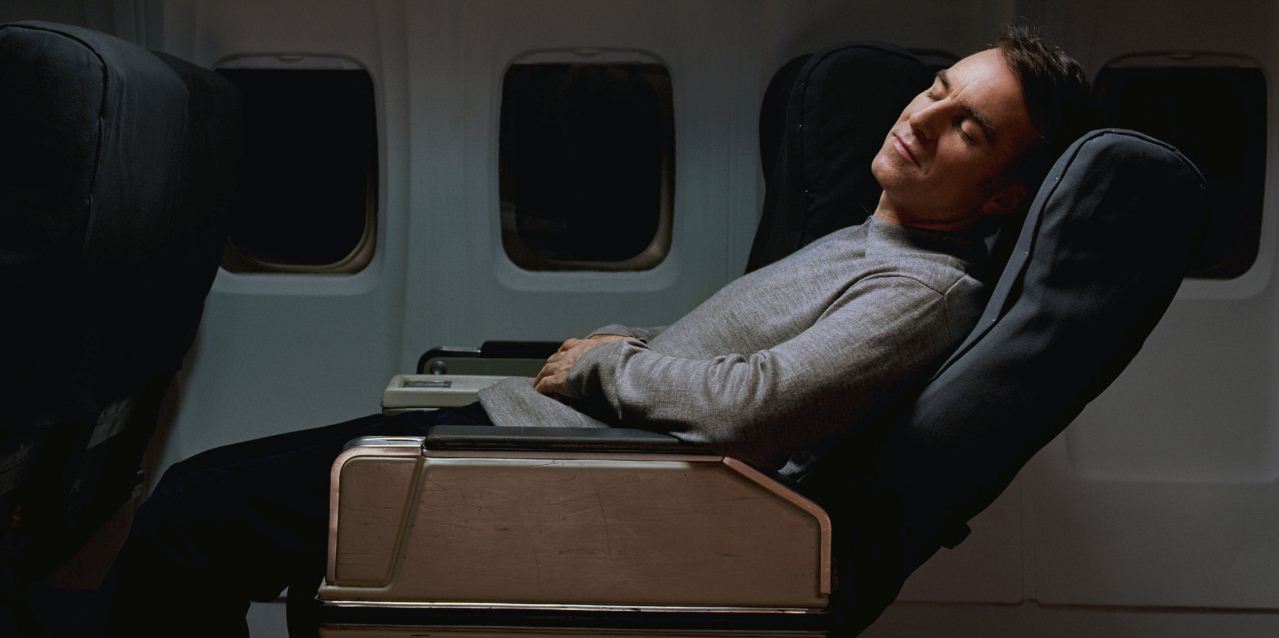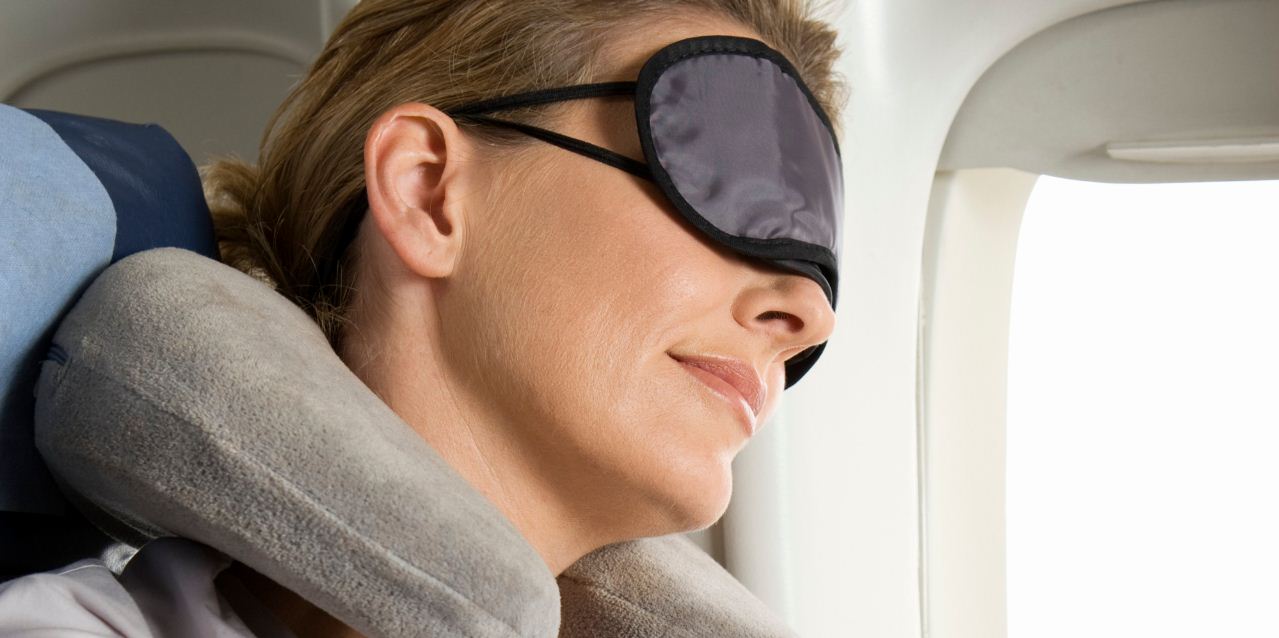A clinical sleep educator shares the best tips in her arsenal for successful in-flight snoozing.
It is the bane of travelers getting on a plane for both business and pleasure—difficulty falling asleep in a seat, especially in coach, and the attendant horrors of jet lag after landing. Studies have shown that lack of sleep can decrease brain performance by 20 percent, so it’s crucial to anyone crossing time zones to rest as much as possible during the flight. Washington, D.C.–based clinical sleep educator and RN Terry Cralle shared her tips for powering down (and getting at least a power nap) on a flight. These are 11 tips on how to sleep better on a plane.
1. Plan ahead. “Planning ahead, though it sounds simple, can be much harder in practice. However, it can make a huge difference in your ability to sleep well before a flight and on it,” says Cralle. If you take the time to do things like pack, plan your transportation to the airport, and organize the things that need to happen at home while you’re away in the days leading up to a flight—not the night before—you will not be nearly as stressed-out, and sleep will come more easily.
2. Meditate. “Recently, guided-meditation audio apps have been gaining a lot of popularity, and rightly so,” says Cralle. “It has been shown that these gentle talks help the brain to relax quickly, especially so when the listener is prompted to imagine they are using all of their senses. Say, if you are guided to a beach-side scene where you imagine hearing the waves, watching the sky, and smelling flowers and the salt air, it really helps you to disengage and fall asleep.”
3. Pack lavender oil. “I’m a big fan of lavender oil, it’s so calming, and is a great, simple thing to bring along on a trip,” says Cralle. “A small study was recently done that shows that people who inhaled 100 percent lavender oil before and during sleep had decreased blood pressure and deeper sleep patterns than those who didn’t.” Put a few drops onto your travel pillow, apply it to your temples and wrists once you’ve settled into your seat, and prepare to dream.
4. Ignore in-flight entertainment. No matter how much you want to see the latest blockbuster, Cralle says, “Skip the movies and TV—the end result of staring at a screen during much your flight means that light is hitting your retinas, and telling your brain and body that it’s daytime, and sleep will be much tougher to achieve.”
5. Make to-do lists. To train your brain not to race and worry when it’s time for rest, Cralle recommends a simple daily practice. “Write down your to-do list well before bed. You want to get any obligations and important tasks out of your mind and onto paper during the day so that the mind is clear at bedtime.”
6. Bring something comforting. To get great shut-eye on a plane, Cralle says, “You want the environment to be as comfortable and predictable as possible. If you have a travel pillow you love, always pack it when traveling. Its scent and familiarity will give your brain and body a behavioral cue that it’s time to relax and let go.” The same effect can be achieved by a cozy scarf or sweater.
7. Cover your eyes. “Wear a good-quality eye mask on your flight,” says Cralle. “There are many different models, so even if you think you hate them, if you shop around you’ll likely find one that’s comfortable for you. That little bit of light from a fellow passenger’s iPad two rows up can ruin your ability to fall asleep. The blue light from modern devices is very alerting to the brain, and absolute darkness prompts your body to produce melatonin.”
8. Step away from the Scotch. While a relaxing adult beverage may be tempting, Cralle advises, “Avoid alcohol. Having a drink in an airport lounge or on the plane is a reflex for many people, especially those who have anxiety around flying. However, it really messes with the quality of your sleep, so, close to bedtime, be conscious about drinking booze and caffeine, of course. Hydrate as much as possible.”
9. Decrease the decibels. “Though you’ve likely heard this before, earplugs are very important to have for your flight and your hotel stay while you’re traveling,” Cralle explains. “Make sure to pack them in your carry-on, and, again, try different brands and designs until you find the ones that feel good to you.” There is so much ambient noise on a jet—which is something airlines are working on muffling now—that you truly need to block out that sound, as well as screaming babies and unnecessary alerts from the cockpit.

10. Incorporate cardio. “The relationship between exercise and sleep is very exciting—we are finding that the connection between the two is bi-directional; i.e., if you get enough of one, the other comes much more easily to you,” says Cralle. “The reality is that 40 percent of Americans are sleep-deficient. If you work to add an extra hour of sleep at night, you’ll be much more apt to exercise, and, when you do—especially before a flight—you will be able to doze off much more easily.”
11. Bank sleep. If in-flight snoozing is simply not an option, due to your utter inability to rest on a plane or because you simply must work while traveling, Cralle points out that a little bit of prep work can help you stave off jet lag. “You actually can bank sleep,” says Cralle. “Prioritize your sleep before a flight, and spend a little extra time sleeping or napping in the week before you depart. Lack of sleep really effects your immune system—and the last thing you want on an important business trip or a long-awaited vacation is to get sick. Banking sleep beforehand will also mitigate the bad effects of jet lag.”































![10 best airports in Asia in 2016 [RANKED] kuala-lumpur-international-airport-best airports in asia in 2016 by skytrax ratings](https://livingnomads.com/wp-content/uploads/2016/08/29/kuala-lumpur-international-airport-best-airports-in-asia-in-2016-by-skytrax-ratings-218x150.jpg)
























